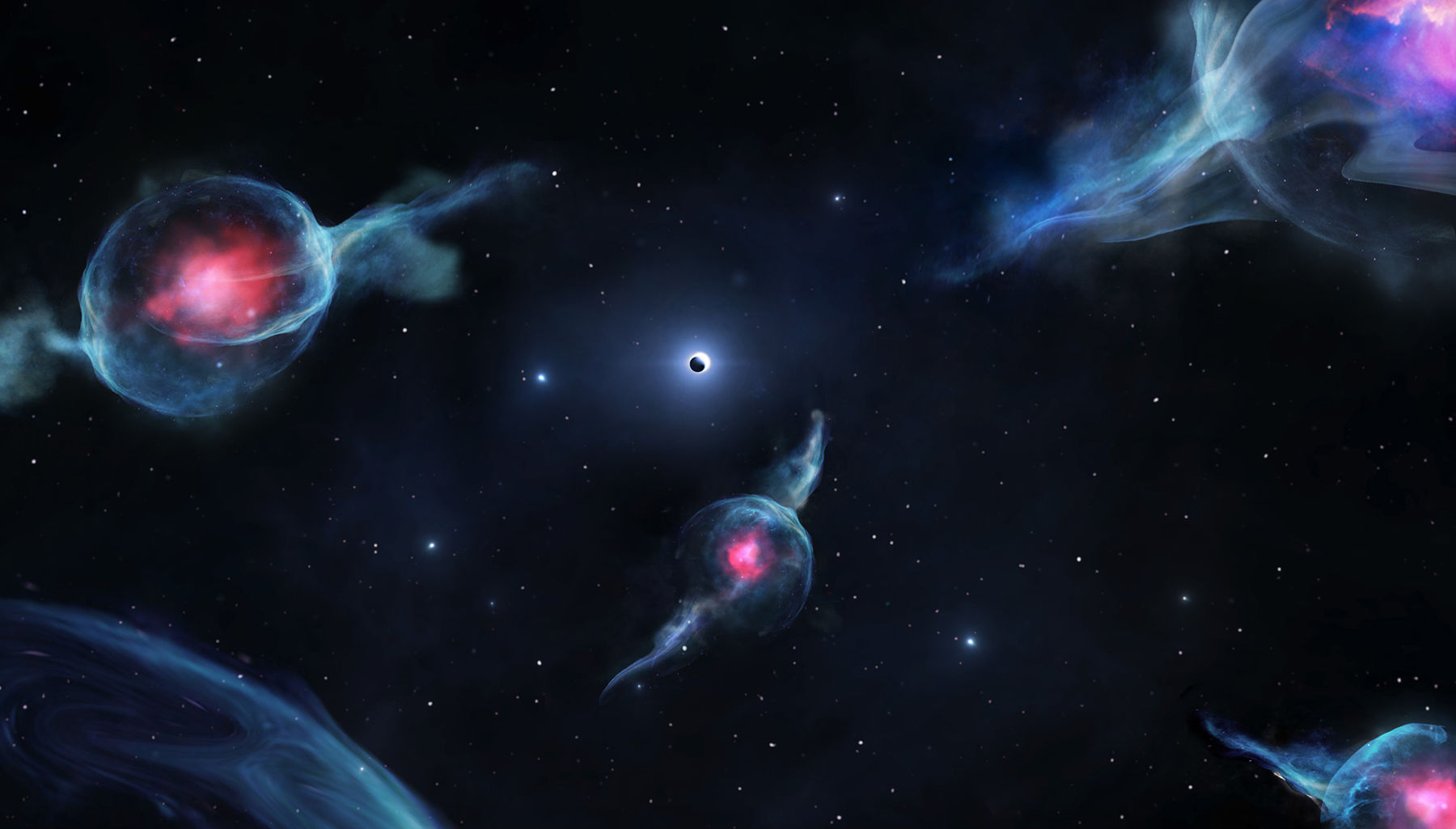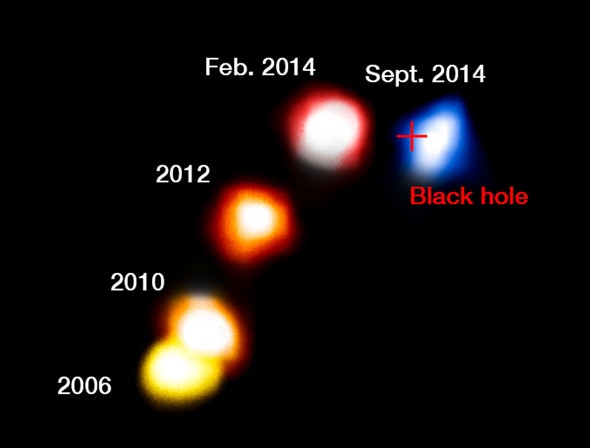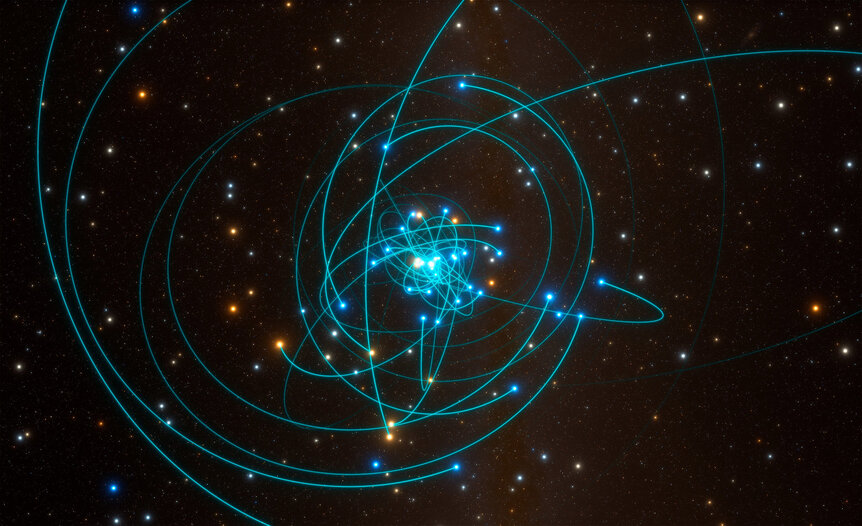Create a free profile to get unlimited access to exclusive videos, sweepstakes, and more!
A weird blob that survived a close pass with a huge black hole is actually three stars enshrouded in dust
G2 isn't one dust cloud, it's three, each with an embedded star.

Mysteries lurk at the dark heart of our Milky Way galaxy.
We know there's an enormous four million solar mass black hole there, called Sgr A*, sitting at the exact center of the galaxy. We also know there's a cluster of young, massive stars around it, called the S Cluster, though its origins are still debated.
But there's also a clutch of weird objects orbiting Sgr A* that appear to be small clouds of dust, which in itself is a little strange. How did they get there? How do they survive so close to the black hole? The more we study them the more difficult it gets to understand what they are.
In a new paper, astronomers looked closely at one such object and found it might instead be three separate stars very close together, each very young and enshrouded in dust. It's a big change over what's been concluded before.
Observations of the galactic center in infrared show lots of interesting objects there. A cloud of dust called G1 was discovered in 2005, and a second, G2, was announced in 2012. Several more have been found since, but G2 is of special interest: For one thing, it appears to be a gas cloud with a smaller, more compact clot of dust inside it. But even cooler, observations over time showed it was moving, and clearly in orbit around the supermassive black hole Sgr A*.
It takes about 260 years to complete a single orbit, and it gets a terrifying 20 billion kilometers away from it. That may sound like a lot — it's about 6 times the distance of Neptune from the Sun — but we're talking a black hole with millions of times the Sun's mass. G2 made such a close pass in 2014, and it was widely expected to be torn apart by the ridiculously powerful tides from the black hole.
… but it survived! That shocked astronomers. What could hold it together under such strain? One idea is that maybe there was a star embedded in the gas, and its gravity kept it intact. But the observations didn't quite fit that idea. Another idea is that it was a binary star, two stars in close orbit, which merged together. Such an event would expel a large amount of gas and dust that would surround the newly coalesced star, which also fit the observations at the time.
But in the new paper the astronomers present new observations that cast doubt on this. G2 shows up in an infrared image, just as it has in previous ones. But they also took spectra, breaking the light up from G2 into many individual wavelengths (colors), and that presented a different situation. Instead of just one object, they saw three: The main object, which they call G2/DSO, and two others that they call OS1 and OS2. All three objects appear in the same spot spatially — they're so close together they blur into a single object — but their spectra show that they're moving at different velocities.
The light from an object moving toward the observer gets compressed, the wavelengths closer together. This is called a blueshift, and both OS1 and OS2 are blueshifted with respect to G2/DSO. So they appear close together but are moving at different speeds, making them look like one object in direct images but three in spectra.
What could this mean? The astronomers conclude they are seeing three separate stars, all enshrouded in clouds, and all on very similar but slightly different orbits (in fact, that's why they called them OS1 and 2; OS stands for "Obedient Stars," because they follow the first one around the black hole). But where did they come from?
They speculate that some time in the recent past, certainly less than a million years ago, a cluster of stars passed too close to the black hole. Clusters can contain dozens, hundreds, or even thousands of stars. Most of the stars would've been torn from the cluster and flung away or dropped into the black hole. Some, though, would've stayed in a tight orbit, and this would include G2 and its obedient followers. If the cluster were very young then some of the stars would have material around them from which they were still forming, and could hold on to them even after passing the black hole.
That's a pretty nifty idea, and it does explain a lot of things. I wonder though… the stars are very close together, and I'd expect after hundreds or thousands of close passes of the black hole they'd get dispersed more. Holding on to their clouds would be difficult as well after so many close passes. I'd love to see some models looking into these issues.
They note that there are other dust-enshrouded objects near Sgr A*, so it may be possible to get their spectra and figure out their orbits as well. It would be interesting indeed if they all share similar enough paths to be linked to a long-dead disrupted star cluster.
And if so, how amazing would it have been to witness such an event? We have telescopes now that could see individual stars in such a cluster, and it wouldn't take long for the immense power of the black hole's gravity to reach out and tear it apart as well as eat much of it.
What a sight that would be, and what we could learn from it! Alas, we missed the chance to see that meal, but at least we can analyze the crumbs left over.




























